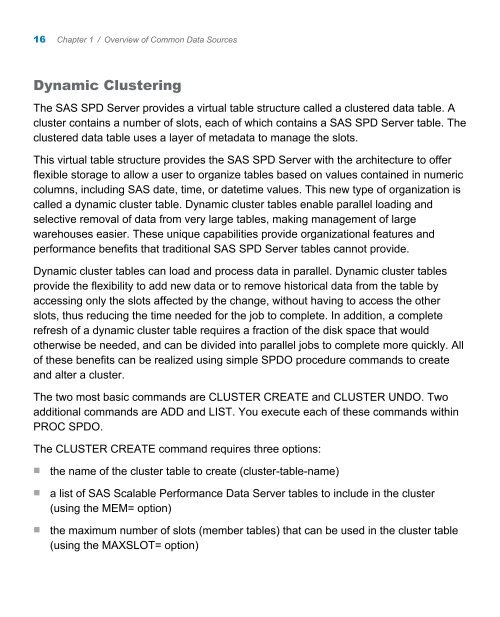SAS 9.3 Intelligence Platform: Data Administration Guide, Second ...
SAS 9.3 Intelligence Platform: Data Administration Guide, Second ...
SAS 9.3 Intelligence Platform: Data Administration Guide, Second ...
You also want an ePaper? Increase the reach of your titles
YUMPU automatically turns print PDFs into web optimized ePapers that Google loves.
16 Chapter 1 / Overview of Common <strong>Data</strong> Sources<br />
Dynamic Clustering<br />
The <strong>SAS</strong> SPD Server provides a virtual table structure called a clustered data table. A<br />
cluster contains a number of slots, each of which contains a <strong>SAS</strong> SPD Server table. The<br />
clustered data table uses a layer of metadata to manage the slots.<br />
This virtual table structure provides the <strong>SAS</strong> SPD Server with the architecture to offer<br />
flexible storage to allow a user to organize tables based on values contained in numeric<br />
columns, including <strong>SAS</strong> date, time, or datetime values. This new type of organization is<br />
called a dynamic cluster table. Dynamic cluster tables enable parallel loading and<br />
selective removal of data from very large tables, making management of large<br />
warehouses easier. These unique capabilities provide organizational features and<br />
performance benefits that traditional <strong>SAS</strong> SPD Server tables cannot provide.<br />
Dynamic cluster tables can load and process data in parallel. Dynamic cluster tables<br />
provide the flexibility to add new data or to remove historical data from the table by<br />
accessing only the slots affected by the change, without having to access the other<br />
slots, thus reducing the time needed for the job to complete. In addition, a complete<br />
refresh of a dynamic cluster table requires a fraction of the disk space that would<br />
otherwise be needed, and can be divided into parallel jobs to complete more quickly. All<br />
of these benefits can be realized using simple SPDO procedure commands to create<br />
and alter a cluster.<br />
The two most basic commands are CLUSTER CREATE and CLUSTER UNDO. Two<br />
additional commands are ADD and LIST. You execute each of these commands within<br />
PROC SPDO.<br />
The CLUSTER CREATE command requires three options:<br />
n the name of the cluster table to create (cluster-table-name)<br />
n a list of <strong>SAS</strong> Scalable Performance <strong>Data</strong> Server tables to include in the cluster<br />
(using the MEM= option)<br />
n the maximum number of slots (member tables) that can be used in the cluster table<br />
(using the MAXSLOT= option)

















